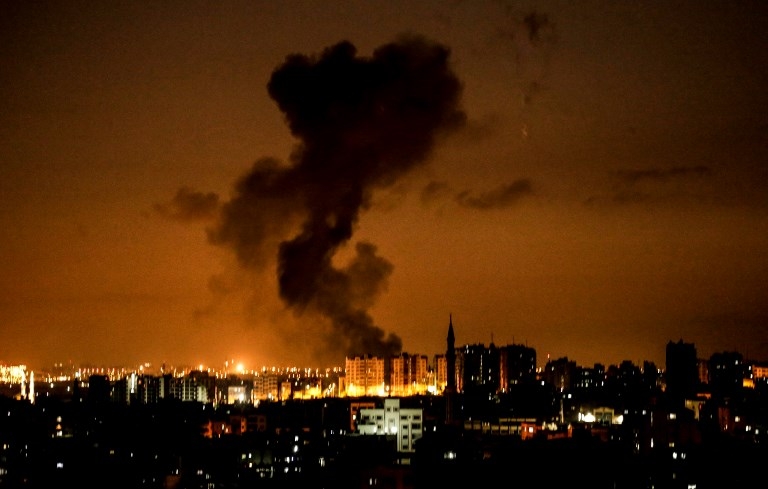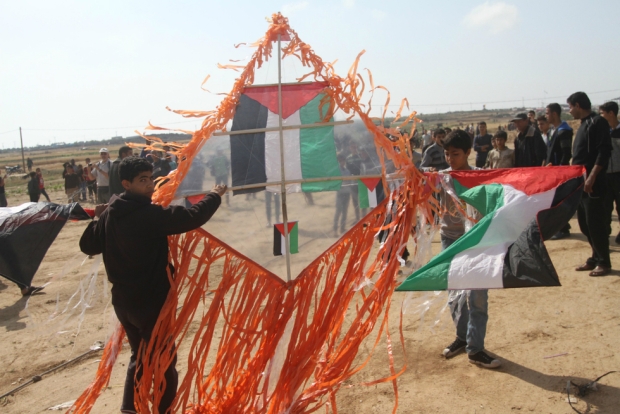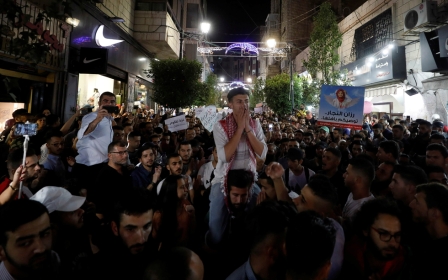Israeli warplanes pound Gaza in response to burning kites

Israeli warplanes on Monday conducted air strikes in the northern Gaza Strip in response to incendiary kites being sent into Israeli territory, the military said, as two Palestinians, including a 13 year old, died later in the day in distinct circumstances.
Israel said it had carried out nine strikes targeting two Hamas compounds and one Hamas weapons manufacturing site and photos showed explosions lighting up the Gaza City skyline.
Colourful kites decorated with flags, slogans and patterns have become a symbol of resistance in the face of overwhelming Israeli military force during weeks of demonstrations.
Some with flaming tails have also been flown towards Israeli territory, causing several fires in farmlands and forests adjacent to Gaza and prompting Israeli officials to warn that kite fliers risk being targeted by snipers.
The Israeli army on Saturday wounded two Palestinians in the Gaza Strip attempting to launch balloons across the border into Israel, officials said.
The Israeli military said on Twitter on Monday that the air strikes had been launched "in response to arson and explosive kites and balloons that've been launched into Israel".
It said it held Hamas responsible for all "violence emanating from the Gaza Strip".
At least 130 Palestinians in Gaza have been killed by Israeli forces and more than 14,600 have been wounded since the beginning of a wave of protests in late March, according to the Gaza health ministry. No Israelis have been killed during the same time frame.
Gaza's health ministry said one person had died east of Gaza City on Monday and named him as 24-year-old Sabri Ahmed Abu Khader.
The Israeli army told Middle East Eye that a man was killed by an unspecified "explosion" when a group of Palestinians tried to breach the fence to cross into Israel.
Later on Monday, the Gaza ministry said 13-year-old Zakariya Hussein Beshbash had succumbed to wounds in the abdomen he sustained two weeks earlier while participating in a demonstration east of al-Bureij refugee camp.
Palestinians participating in the Great March of Return since 30 March are calling to return to the homes their families fled or were forced from in 1948 during the violent which led to the creation of Israel.
Gaza has been blockaded by Israel since Hamas took control of the territory in 2007 after winning elections the previous year. The two sides have fought three wars since 2008 and observe a tense ceasefire.
Protesters in Gaza last week told Middle East Eye they intended to continue launching their kites despite the risk of getting shot, with some attaching fishing nets to their tails in an attempt to disrupt Israel drones operating in the skies over Gaza.
Some refer to the kites as a "new generation of F-16s", a reference to the Israeli fighter jet often seen in the skies over Gaza.
“The reason why these youth and children moved from flying harmless kites to burning ones is the way Israeli forces responded since day one,” Warda al-Zebda, a 37-year-old woman, who participates frequently in the protests, told MEE.
“People here have become aware that whether they use peaceful methods or not, they will always be faced with excessive force and showered with live ammunition; the result is always the same.”
New MEE newsletter: Jerusalem Dispatch
Sign up to get the latest insights and analysis on Israel-Palestine, alongside Turkey Unpacked and other MEE newsletters
Middle East Eye delivers independent and unrivalled coverage and analysis of the Middle East, North Africa and beyond. To learn more about republishing this content and the associated fees, please fill out this form. More about MEE can be found here.





